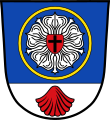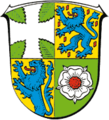| This article relies excessively on references to primary sources. Please improve this article by adding secondary or tertiary sources. Find sources: "Luther rose" – news · newspapers · books · scholar · JSTOR (April 2011) (Learn how and when to remove this message) |


The Luther rose or Luther seal is a widely recognized symbol for Lutheranism. It was the seal that was designed for Martin Luther at the behest of John Frederick of Saxony in 1530, while Luther was staying at the Coburg Fortress during the Diet of Augsburg. Lazarus Spengler, to whom Luther wrote his interpretation below, sent Luther a drawing of this seal. Luther saw it as a compendium or expression of his theology and faith, which he used to authorize his correspondence. Luther informed Philipp Melanchthon on 15 September 1530, that the Prince had personally visited him in the Coburg fortress and presented him with a signet ring, presumably displaying the seal.
Parts of the seal connected to Luther before 1530
A single rose had been known as Luther’s emblem since 1520, when Wolfgang Stöckel in Leipzig published one of Luther's sermons with a woodcut of the reformer. This was the first contemporary depiction of Martin Luther.
Luther's doctoral ring displayed a heart-like shield, the symbol of the Holy Trinity.
Luther's interpretation of his seal

In an 8 July 1530 letter to Lazarus Spengler, Luther interprets his seal:
Grace and peace from the Lord. As you desire to know whether my painted seal, which you sent to me, has hit the mark, I shall answer most amiably and tell you my original thoughts and reason about why my seal is a symbol of my theology. The first should be a black cross in a heart, which retains its natural color, so that I myself would be reminded that faith in the Crucified saves us. "For one who believes from the heart will be justified" (Romans 10:10). Although it is indeed a black cross, which mortifies and which should also cause pain, it leaves the heart in its natural colour. It does not corrupt nature, that is, it does not kill but keeps alive. "The just shall live by faith" (Romans 1:17) but by faith in the crucified. Such a heart should stand in the middle of a white rose, to show that faith gives joy, comfort, and peace. In other words, it places the believer into a white, joyous rose, for this faith does not give peace and joy like the world gives (John 14:27). That is why the rose should be white and not red, for white is the color of the spirits and the angels (cf. Matthew 28:3; John 20:12). Such a rose should stand in a sky-blue field, symbolising that such joy in spirit and faith is a beginning of the heavenly future joy, which begins already, but is grasped in hope, not yet revealed. And around this field is a golden ring, symbolising that such blessedness in Heaven lasts forever and has no end. Such blessedness is exquisite, beyond all joy and goods, just as gold is the most valuable, most precious and best metal. This is my compendium theologiae . I have wanted to show it to you in good friendship, hoping for your appreciation. May Christ, our beloved Lord, be with your spirit until the life hereafter. Amen.
In Byzantine Rite Lutheranism
Churches of Byzantine Rite Lutheranism, such as the Ukrainian Lutheran Church, use the Luther rose with a three-barred Orthodox cross in the centre.
Use in coats of arms
The Luther rose is used in many coats of arms. The assumption that Martin Luther had visited any of these places is not confirmed.
German and Austrian arms
-
 Langenholtensen
Langenholtensen
-
 Kirchberg-Thening
Kirchberg-Thening
-
 Rodgau
Rodgau
-
 Wain
Wain
-
 Neuendettelsau
Neuendettelsau
-
 Golden Luther rose in the coat of arms of Arriach village
Golden Luther rose in the coat of arms of Arriach village
-
 Ramsau am Dachstein
Ramsau am Dachstein
-
 Greifenstein
Greifenstein
See also
- Rose (heraldry) – Heraldic symbol
- Rose Cross – Western esoteric symbol
- Rose symbolism
Notes
- "The catalog of emblems is the fruit of sublime talented steps" (in Polish). Retrieved 1 November 2020.
- "The Luther rose" (in Polish). Retrieved 24 August 2024.
- ^ LW 49, 356-359.
- Translated from WA Br 5, 445
- Kudrick, Serhiy; Kokovsky, Taras; Stetsyuk, Oleg (31 October 2007). ""Українська Лютеранська Церква – Церква, яка бере за основу лише Святе Письмо – Біблію, являється консервативною Церквою у питаннях віросповідання"" (in Ukrainian). РІСУ - Релігійно-інформаційна служба України. Retrieved 19 September 2018.
УЛЦ є правонаступницею довоєнної Української Євангельської Церкви Авгсбурзького віросповідання (УЄЦАВ), що визначала себе як Церква Східного (Візантійського) обряду. Звідси і використання символіки цього обряду і Літургії Івана Золотустого.
Bibliography
- Luther, Martin. D. Martin Luthers Werke, Kritische Gesamtausgabe. Briefwechsel. 18 vols. Weimar: Verlag Hermann Böhlaus Nachfolger, 1930–85. (abbreviated as WABr above).
- Luther, Martin. Luther's Works. 55 Volumes. Various translators. St. Louis: Concordia Publishing House; Minneapolis: Fortress Press, 1957–1986. CD-ROM edition, 2001. (abbreviated as LW above).
Further reading
- Korsch, Dietrich (2004). "Luther's Seal as an Elementary Interpretation of His Theology". In Wengert, Timothy J. (ed.). Harvesting Martin Luther's reflections on theology, ethics, and the church. Grand Rapids: Eerdmans. pp. 56–77. ISBN 978-0-8028-2486-8.